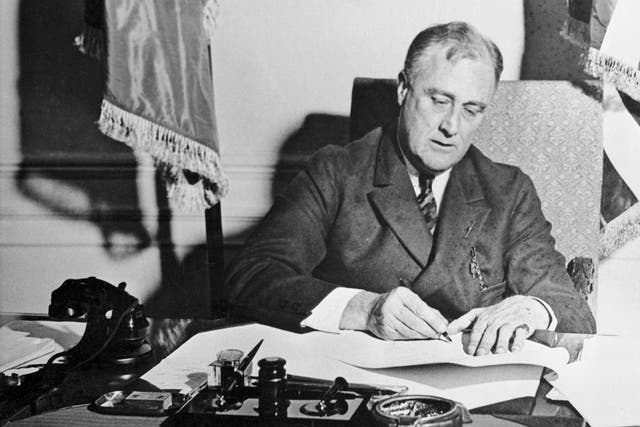

The New Deal was a series of programs and projects instituted during the Great Depression by President Franklin D. Roosevelt that aimed to restore prosperity to Americans. When Roosevelt took office in 1933, he acted swiftly to stabilize the economy and provide jobs and relief to those who were suffering. Over the next eight years, the government instituted a series of experimental New Deal projects and programs, such as the CCC, the WPA, the TVA, the SEC and others. Roosevelt’s New Deal fundamentally and permanently changed the U.S. federal government by expanding its size and scope—especially its role in the economy.
Franklin D. Roosevelt's New DealOn March 4, 1933, during the bleakest days of the Great Depression, newly elected President Franklin D. Roosevelt delivered his first inaugural address before 100,000 people on Washington’s Capitol Plaza.
“First of all,” he said, “let me assert my firm belief that the only thing we have to fear is fear itself.”
He promised that he would act swiftly to face the “dark realities of the moment” and assured Americans that he would “wage a war against the emergency” just as though “we were in fact invaded by a foreign foe.” His speech gave many people confidence that they’d elected a man who was not afraid to take bold steps to solve the nation’s problems.
The Hoover Dam, LaGuardia Airport and the Bay Bridge were all part of FDR's New Deal investment.
In the 1930s, the FHA refused to insure houses for Black families, or even insure houses in white neighborhoods that were too close to Black ones.
While the New Deal did have a lasting impact on the U.S. economy, other significant factors contributed toward ending the Great Depression by June 1938.
Meanwhile, the New Deal itself confronted one political setback after another. Arguing that they represented an unconstitutional extension of federal authority, the conservative majority on the Supreme Court had already invalidated reform initiatives like the National Recovery Administration and the Agricultural Adjustment Administration.
In order to protect his programs from further meddling, in 1937 President Roosevelt announced a plan to add enough liberal justices to the Court to neutralize the “obstructionist” conservatives.
This “Court-packing” turned out to be unnecessary—soon after they caught wind of the plan, the conservative justices started voting to uphold New Deal projects—but the episode did a good deal of public-relations damage to the administration and gave ammunition to many of the president’s Congressional opponents.
That same year, the economy slipped back into a recession when the government reduced its stimulus spending. Despite this seeming vindication of New Deal policies, increasing anti-Roosevelt sentiment made it difficult for him to enact any new programs.
On December 7, 1941, the Japanese bombed Pearl Harbor and the United States entered World War II. The war effort stimulated American industry and, as a result, effectively ended the Great Depression.
From 1933 until 1941, President Roosevelt’s New Deal programs and policies did more than just adjust interest rates, tinker with farm subsidies and create short-term make-work programs.
They created a brand-new, if tenuous, political coalition that included white working people, African Americans and left-wing intellectuals. More women entered the workforce as Roosevelt expanded the number of secretarial roles in government. These groups rarely shared the same interests—at least, they rarely thought they did— but they did share a powerful belief that an interventionist government was good for their families, the economy and the nation.
Their coalition has splintered over time, but many of the New Deal programs that bound them together—Social Security, unemployment insurance and federal agricultural subsidies, for instance—are still with us today.